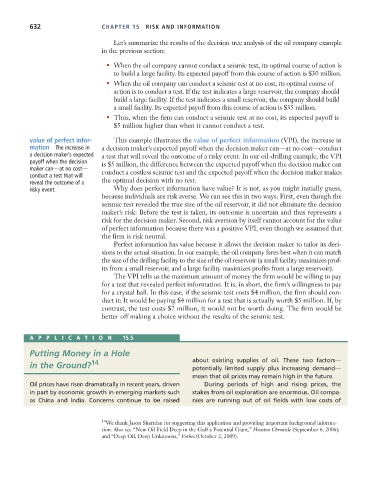Page 658 - Microeconomics, Fourth Edition
P. 658
c15riskandinformation.qxd 8/16/10 11:10 AM Page 632
632 CHAPTER 15 RISK AND INFORMATION
Let’s summarize the results of the decision tree analysis of the oil company example
in the previous section:
• When the oil company cannot conduct a seismic test, its optimal course of action is
to build a large facility. Its expected payoff from this course of action is $30 million.
• When the oil company can conduct a seismic test at no cost, its optimal course of
action is to conduct a test. If the test indicates a large reservoir, the company should
build a large facility. If the test indicates a small reservoir, the company should build
a small facility. Its expected payoff from this course of action is $35 million.
• Thus, when the firm can conduct a seismic test at no cost, its expected payoff is
$5 million higher than when it cannot conduct a test.
value of perfect infor- This example illustrates the value of perfect information (VPI), the increase in
mation The increase in a decision maker’s expected payoff when the decision maker can—at no cost—conduct
a decision maker’s expected a test that will reveal the outcome of a risky event. In our oil-drilling example, the VPI
payoff when the decision is $5 million, the difference between the expected payoff when the decision maker can
maker can—at no cost— conduct a costless seismic test and the expected payoff when the decision maker makes
conduct a test that will
reveal the outcome of a the optimal decision with no test.
risky event. Why does perfect information have value? It is not, as you might initially guess,
because individuals are risk averse. We can see this in two ways. First, even though the
seismic test revealed the true size of the oil reservoir, it did not eliminate the decision
maker’s risk: Before the test is taken, its outcome is uncertain and thus represents a
risk for the decision maker. Second, risk aversion by itself cannot account for the value
of perfect information because there was a positive VPI, even though we assumed that
the firm is risk neutral.
Perfect information has value because it allows the decision maker to tailor its deci-
sions to the actual situation. In our example, the oil company fares best when it can match
the size of the drilling facility to the size of the oil reservoir (a small facility maximizes prof-
its from a small reservoir, and a large facility maximizes profits from a large reservoir).
The VPI tells us the maximum amount of money the firm would be willing to pay
for a test that revealed perfect information. It is, in short, the firm’s willingness to pay
for a crystal ball. In this case, if the seismic test costs $4 million, the firm should con-
duct it: It would be paying $4 million for a test that is actually worth $5 million. If, by
contrast, the test costs $7 million, it would not be worth doing. The firm would be
better off making a choice without the results of the seismic test.
APPLICA TION 15.5
Putting Money in a Hole
about existing supplies of oil. These two factors—
in the Ground? 14 potentially limited supply plus increasing demand—
mean that oil prices may remain high in the future.
Oil prices have risen dramatically in recent years, driven During periods of high and rising prices, the
in part by economic growth in emerging markets such stakes from oil exploration are enormous. Oil compa-
as China and India. Concerns continue to be raised nies are running out of oil fields with low costs of
14 We thank Jason Sheridan for suggesting this application and providing important background informa-
tion. Also see “New Oil Field Deep in the Gulf a Potential Giant,” Houston Chronicle (September 6, 2006);
and “Deep Oil, Deep Unknowns,” Forbes (October 2, 2009).

